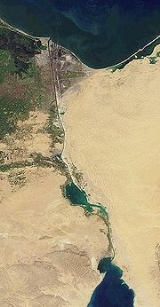
and the Red Sea
. Opened in November 1869 after 10 years of construction work, it allows water transportation
between Europe and Asia without navigation around Africa
. The northern terminus is Port Said
and the southern terminus is Port Tawfik at the city of Suez
. Ismailia
lies on its west bank, 3 km (1.9 mi) north of the half-way point.
When first built, the canal was 164 km (101.9 mi) long and 8 m (26.2 ft) deep.
1854 In Egypt, the Suez Canal, linking the Mediterranean Sea with the Red Sea, is given the necessary royal concession.
1859 British and French engineers break ground for the Suez Canal.
1867 The first ship passes through the Suez Canal.
1869 In Egypt, the Suez Canal, linking the Mediterranean Sea with the Red Sea, is inaugurated.
1888 The Convention of Constantinople is signed, guaranteeing free maritime passage through the Suez Canal during war and peace.
1956 Following the World Bank's refusal to fund building the Aswan High Dam, Egyptian leader Gamal Abdel Nasser nationalizes the Suez Canal sparking international condemnation.
1956 Suez Crisis begins: Israeli forces invade the Sinai Peninsula and push Egyptian forces back toward the Suez Canal.
1956 Suez Crisis: The United Kingdom and France begin bombing Egypt to force the reopening of the Suez Canal.
1957 Egypt re-opens the Suez Canal after the Suez Crisis.
1957 The Suez Canal in Egypt is cleared and opens to shipping.

